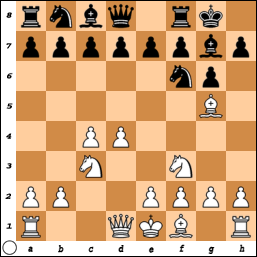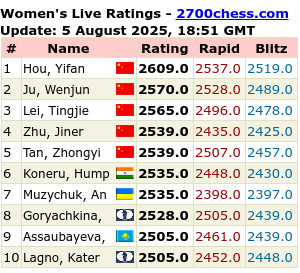You'll be able to read many obituaries and assessments of Smyslov's life, chess, and indeed musicianship ( for example here at the Guardian [with the sad note that "Smyslov and his wife of more than half a century spent their final few years in near-poverty as his heart ailment deteriorated"] ) but on my part I wanted to show his recent contribution to my chess development.
Not, of course a personal contribution, that would be too remarkable, but rather his contribution to the King's Indian.
In my attempts to play the King's Indian as my defence to 1.d4, I have been met a few times with an early Bg5 from White. Not an immediate 2.Bg5, which is a distinct Trompovsky attempt, but a few moves later.
I originally thought that this was an attempt to step out of book, but no, it is a specific variation, developed by, and named after Vassily Smyslov.
Here is the main position, after the moves 1d4 Nf6 2.c4 g6 3.Nc3 Bg7 4Nf3 0-0 or d6 5.Bg5.
 [ 5.Bg5...]
[ 5.Bg5...]
I always continued in standard fashion with the idea to play the thematic, and eventual e5, but this turns out not to be the best way of playing against it.
What to play then ? The answer is simple. When playing against the Smyslov Variation as Black, do as the great man did himself, and play the Smyslov Defence !
This involves not forcing e5, but rather playing an early c5 ( which is a standard move in the King's Indian, just not the way I play it ) and then Bf5.
This allows Black to play Ne4, and also covers b1 and on many occasions allows an attack versus the b2-pawn.
Since this is a recent discovery for me (thanks to "Starting Out: King's Indian" and Joe Gallagher), I have only played this once. A loss, but more on account of my ineptitude and lack of skill, than anything else. As in much of chess knowledge, the Master presents the ideas and we attempt to interpret and execute them successfully.
Anyway, presented below are two games. The first is from the Donner Memorial Tournament in 1994 with Smyslov as Black playing his own defence against his own invention ! Naturally, he wins.
The other is an example from 2001 of Black trying to force e5, White meeting it with Rd1, and eventually winning.
29 March, 2010
Vassily Smyslov 1921 -2010
Posted by Signalman at 19:26
Labels: King's Indian, Smyslov
Subscribe to:
Post Comments (Atom)


0 comments:
Post a Comment